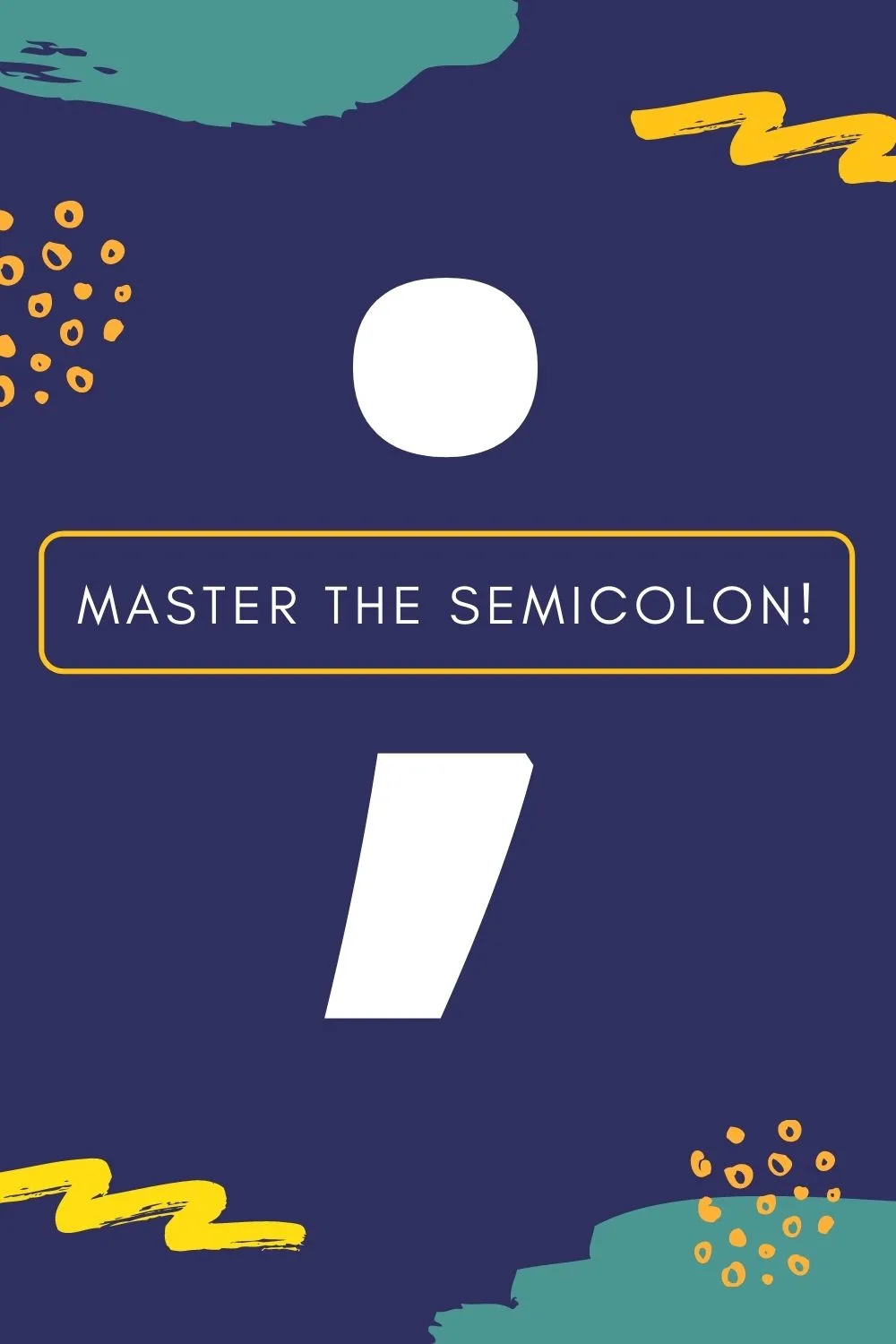Did you ever think that punctuation marks have the ability to intimidate humans, too?
And, did you ever feel like some punctuations are more superior than others?
I bet you’ve already guessed that I’m referring to the nonetheless arrogant-seeming marks, semicolons.
Now, let’s read on to find out how to upscale writing intricacy by using this mixed-bred punctuation.
How to use semicolons
First off, semicolons are used in listing a heavily comma-encapsulated series, or in other words, a complex list. The second purpose of semicolons is for tethering two closely-related independent clauses minus the coordinating conjunctions, or by linking two clauses altogether with conjunctive adverbs.
What exactly is a semicolon?
A semicolon, also known as a “super-comma”, is the hybrid offspring of the comma and the period, or full stop for the Brits.
This word is also optionally written with a hyphen in between (semi-colon).
Semicolon usage is stylistically discretionary which means alternative writing patterns are available lest they don’t come in handy.
It is also stronger than a comma but less powerful than a period, meaning its one foot is in the water while the other is on the boat.
Hence, its main task is to bind thoughts that are less terminal to be concluded with a period, yet too comprehensive to only be chopped by a comma.
So, who invented, albeit more like perpetrated instead, this contentious punctuation’s amalgamation?
Let’s flip a couple of pages back to the fifteenth century to find out.
Historical background of the semicolon
Cecelia Watson, the author of the encyclopedic book on semicolons, has explicitly covered this punctuation’s history.
According to her, it was during the retranscription and restoration of old texts that someone had whimsically altered the history of punctuation marks for good.
In 1494, printer and publisher Aldus Manutius of Venice, Italy tinkered with non-lexical symbols to link two mutually-inclusive ideas together.
This particularly happened when people, especially publishers, had more experimental control over text entities.
A couple of centuries later, punctuations became super notorious that even music has been used to interpret their function.
Punctuations were then considered to correspond with musical intervals which are also represented by rest symbols.
Later, around the early 1800s, American grammarian Goold Brown also published a meta-analysis of more than five hundred grammar books.
His utterly prescriptive observations of the English grammar, including punctuations, led to the fossilization of semicolons.
Thus, thanks to our overtly logical ancestors for passing on this timeless linguistic heirloom.
Using the semicolon
As briefly explained paragraphs ago, semicolons have two main purposes which are to segregate a complex list and to connect two interdependent clauses.
To elucidate these circumstances more clearly, let’s delve into each aspect further by studying some examples.
Semicolons in listing series
Sometimes, we may have to create a comma-infested list of entities together with some descriptors.
In this case, the power of commas is insufficient in segregating the items, thereby necessitating the intervention of semicolons.
Semicolons in complex address lists
Commas are a rule of thumb in writing addresses to separate each specific location such as city, state, and country.
When we have to serially list several places in a single sentence, we need to use semicolons to serve as sturdier barriers than commas.
Well, this person seems to be a lot wealthier than the rest of us for having the capacity to splurge a hefty sum of money to travel around Central Africa.
Since capital cities have to be separated by commas when paired with their countries, the role of semicolons is undebatable in this type of list.
| Example: Peter Murphy, 123 Main Street, Anytown, USA; Jane Doe, 456 Oak Avenue, Othertown, USA; Jake Ellenberger, 789 Elm Street, Yetanothertown, USA |
| Example: Dr. Mary Johnson, MD; Dr. James Lee, PhD; Dr. Susan Chen, DVM |
| Example: Attendees: John Smith, Jane Doe, Tom Johnson; Presenters: Dr. Mary Johnson, Dr. James Lee, Dr. Susan Chen |
| Example: My favorite books are Pride and Prejudice by Jane Austen; 1984 by George Orwell; To Kill a Mockingbird by Harper Lee; and The Great Gatsby by F. Scott Fitzgerald. |
| Example: The members of the group are: John Smith, Manager; Jane Doe, Assistant Manager; Tom Johnson, Sales Representative; and Sarah Lee, Customer Service Specialist. |
| Example: The concert lineup includes: Drake, headlining; Taylor Swift, opening act; and Beyoncé, special guest performer. |
Semicolons and appositives
Another possible scenario where semicolons would duly serve their purpose is with appositives.
Apposition is the process of further describing nouns with the assistance of other nouns, noun phrases, or pronouns.
These speech elements may be stylistically added in the sentence for the sake of further information clarification.
Ms. Sanders, my highschool tutor; Greg, her boyfriend; and I coincidentally met at a concert in my hometown last weekend.
See how the semicolons helped in clarifying the presence of only three subjects, instead of five, in the sentence above?
Without them, we would easily misinterpret how many people were actually present in the story.
Let us have a look at some more examples to get a better picture on how this actually works:
| Example: My father, a successful businessman; my mother, a renowned artist; and my brother, a talented musician, all live in the same city. |
| Example: The car, a classic Ferrari; the motorcycle, a Harley Davidson; and the boat, a small fishing boat, were all heavily damaged in the storm. |
| Example: My favorite musician, Samra; my favorite actor, Brad Pitt; and my favorite author, J.K. Rowling, all inspire me creatively. |
| Example: The restaurant's specialties, sushi; sashimi; and sake, are all popular with customers. |
| Example: The painting, a masterpiece by Claude Monet; the sculpture, a work by Michelangelo; and the photograph, a print by David Becks, were all on display at the museum. |
Semicolons in connecting clauses
Fundamentally, conjoining two independent clauses in one sentence is the task of either the coordinating conjunctions or conjunctive adverbs.
However, if a writer wants to transcend a more forceful effect on the readers, particularly with interrelated independent clauses, we can utilize semicolons as well.
Semicolons and coordinating conjunctions
Coordinating conjunctions join two words, phrases, or clauses that weigh equitably.
The FANBOYS, however, are granted some leave credits every once in a while.
When they are on official leave, semicolons are automatically called as their relievers.
Their performance appraisals suggest that they do quite an amazing job in emanating emphatic and implicit effects.
Modern style guides suggest that the second clause should not start with an uppercase unless headed by proper nouns and the narcissistic pronoun, I.
| Example: She loves to go out; he prefers to stay home. |
| Example: The project was completed ahead of schedule; she received an award for her awesome work. |
| Example: I have a meeting this afternoon; I need to prepare for it. |
| Example: The stadium was full; we decided to go dancing instead. |
| Example: He is a talented musician; she is a successful singer. |
Semicolons and conjunctive adverbs
Logical thought connections may also be demonstrated by conjunctive adverbs or adverbial connectors.
Conjunctive adverbs are functionally used to add ideas, express consequential results, or denote sequences.
Sharing the same purpose as with coordinating conjunctions, semicolons may also be used to state correlated ideas within a sentence.
When this special type of adverbs introduces the second clause, a post-comma placement is required by default.

Let’s have a look at a couple more examples where semicolons and conjunctive adverbs go hand in hand:
| Example: Raclette, a traditional Swiss dish, consists of melted cheese served with potatoes and other accompaniments; however, it can be quite heavy and rich. |
| Example: The sport, a popular pastime in many countries, requires endurance and skill; however, it can also be dangerous without proper equipment and training. |
| Example: The city, known for its vibrant nightlife, has many attractions; nonetheless, it can be overwhelming for some visitors. |
| Example: The book, a New York Times bestseller, has a fascinating plot; nonetheless, the writing style is very weird. |
| Example: The movie, a Hollywood blockbuster, features a talented cast; on the other hand, the story is rather absurd. |
When not to use semicolons
Deciding when to avoid semicolons in writing is pretty straightforward.
When the ideas aren’t closely related, then they should be separated by periods instead.
We should not single out an introductory dependent clause by a semicolon either since this is the job of commas.
I bet the donts are easier to remember than the dos.
So, the next time you get entangled in a semicolon-decision, refer to these guides instead.
Conclusion
Hardcore prescriptivists may overanalyze punctuation marks including semicolons.
Whereas, avid descriptivists may lean more towards their stylistic roles.
I’d like to end this post by saying that audience consideration is the most important factor regarding their usage or non-usage.
At the end of the day, text intelligibility and readability should be presumed a priori.
Now that you know everything about semicolon usage, what about studying a bit about colons?

Hey fellow Linguaholics! It’s me, Marcel. I am the proud owner of linguaholic.com. Languages have always been my passion and I have studied Linguistics, Computational Linguistics and Sinology at the University of Zurich. It is my utmost pleasure to share with all of you guys what I know about languages and linguistics in general.

